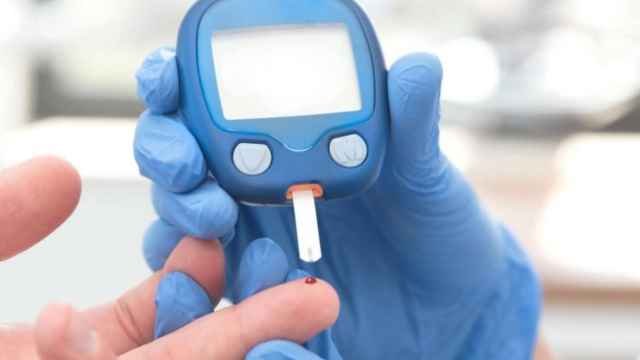November 4, 2025 : A growing body of scientific research is shedding new light on why India continues to experience an alarming rise in diabetes cases, especially Type 2 diabetes, even among young and seemingly healthy individuals. According to new findings by global endocrinologists and metabolic researchers, a cluster of “hidden blood markers” may be quietly driving the country’s diabetes epidemic, making Indians more vulnerable than many other populations worldwide. These markers, often overlooked in routine medical checkups, include chronic inflammation indicators, early insulin resistance signals, abnormal lipid patterns, and genetic predisposition markers that remain undetected until the disease has already progressed.
Doctors say India’s diabetes crisis cannot be explained by lifestyle alone. While poor diet, sedentary habits, and stress play major roles, researchers now believe that Indians carry unique biological characteristics—including lower muscle mass, higher visceral fat, and a distinct metabolic profile—that make them develop diabetes at lower BMI levels than Western populations. This means a person who appears “normal weight” by global standards could still be pre-diabetic or diabetic in India.
One of the major hidden markers gaining attention is high fasting insulin, a sign of early insulin resistance. Many individuals with normal fasting sugar levels still have elevated insulin levels, meaning their body is working overtime to regulate glucose. Because fasting sugar and HbA1c tests often fail to detect early dysfunction, millions of Indians may be living with pre-diabetes without knowing it. Doctors warn that by the time blood sugar rises, insulin resistance could have been building silently for years.
Another critical hidden factor is chronic low-grade inflammation, measured through markers like hs-CRP (high-sensitivity C-reactive protein). Studies show that many Indians have elevated inflammation levels due to lifestyle, air pollution, poor sleep, mental stress, and abdominal fat accumulation. This inflammation directly interferes with insulin function, paving the way for diabetes and other metabolic disorders. Researchers stress that inflammation must be treated as seriously as high sugar levels.
Lipid markers also paint a concerning picture. Indian patients often have a characteristic pattern called “atherogenic dyslipidemia”, which includes high triglycerides, low HDL (good cholesterol), and small dense LDL particles. Even if total cholesterol appears normal, these hidden lipid abnormalities dramatically increase diabetes and heart disease risks. Doctors say that routine health checks focusing only on total cholesterol or LDL miss the deeper metabolic dysfunction common among Indians.
Scientists are also studying genetic markers that predispose Indians to impaired insulin secretion. Variants in genes such as TCF7L2, KCNQ1, and HHEX are more common in South Asians and reduce the pancreas’s ability to produce insulin under stress. This means even slight fluctuations in lifestyle or weight can push genetically susceptible individuals toward diabetes. When genetic vulnerability combines with modern lifestyles—high-carb diets, processed food, long sitting hours—the result is an early and aggressive onset of the disease.
New research has also highlighted the role of gut microbiome imbalance, another hidden factor contributing to insulin resistance. Diets low in fiber and high in refined carbohydrates disrupt the gut environment, promoting harmful bacteria that trigger inflammation and impair glucose metabolism. This connection is especially crucial in India, where traditional diets rich in vegetables and whole grains are rapidly being replaced by fast food and packaged snacks.
Doctors say the key to controlling India’s diabetes epidemic lies in early detection of these hidden markers rather than waiting for diabetes to appear. Experts recommend advanced testing for high-risk individuals—such as those with family history, obesity, polycystic ovary syndrome (PCOS), hypertension, or sedentary occupations. Tests such as fasting insulin, HOMA-IR, hs-CRP, apolipoprotein B, fasting C-peptide, and detailed lipid profiles provide a deeper understanding of metabolic health long before sugar levels become abnormal.
In addition to testing, lifestyle interventions remain essential. Doctors emphasize increasing protein intake, engaging in regular strength training to build muscle mass, improving sleep patterns, and reducing stress—all of which directly influence insulin function. Dietary habits must also shift toward whole foods, higher fiber, and reduced refined carbohydrates. Replacing polished rice and wheat with millets, legumes, and vegetables can significantly help control insulin resistance.
Experts urge India to take preventive healthcare more seriously. Public awareness campaigns, workplace wellness initiatives, school health programs, and early screening drives could help millions identify hidden metabolic risks before they convert to full-blown diabetes. Doctors also stress that healthcare systems must update diagnostic guidelines to include advanced metabolic tests for Indian patients rather than relying solely on traditional sugar-based tests.
Researchers hope that recognizing the role of hidden blood markers will reshape the way India approaches diabetes detection and management. The country can no longer afford to treat diabetes as a lifestyle disease alone; it is a complex interplay of biology, genetics, metabolism, and environment. By focusing on early intervention, India has the opportunity to reduce its soaring diabetes burden and protect the next generation from an epidemic that is striking people younger with each passing decade.
Summary
New research shows hidden blood markers—insulin resistance, inflammation, lipid abnormalities, and genetic predisposition—may be driving India’s rising diabetes cases. Early screening and lifestyle changes are essential to prevent widespread metabolic disease.


